MERCEDES-BENZ G-Class 2009 W463 Owner's Guide
Manufacturer: MERCEDES-BENZ, Model Year: 2009, Model line: G-Class, Model: MERCEDES-BENZ G-Class 2009 W463Pages: 264, PDF Size: 6.98 MB
Page 31 of 264
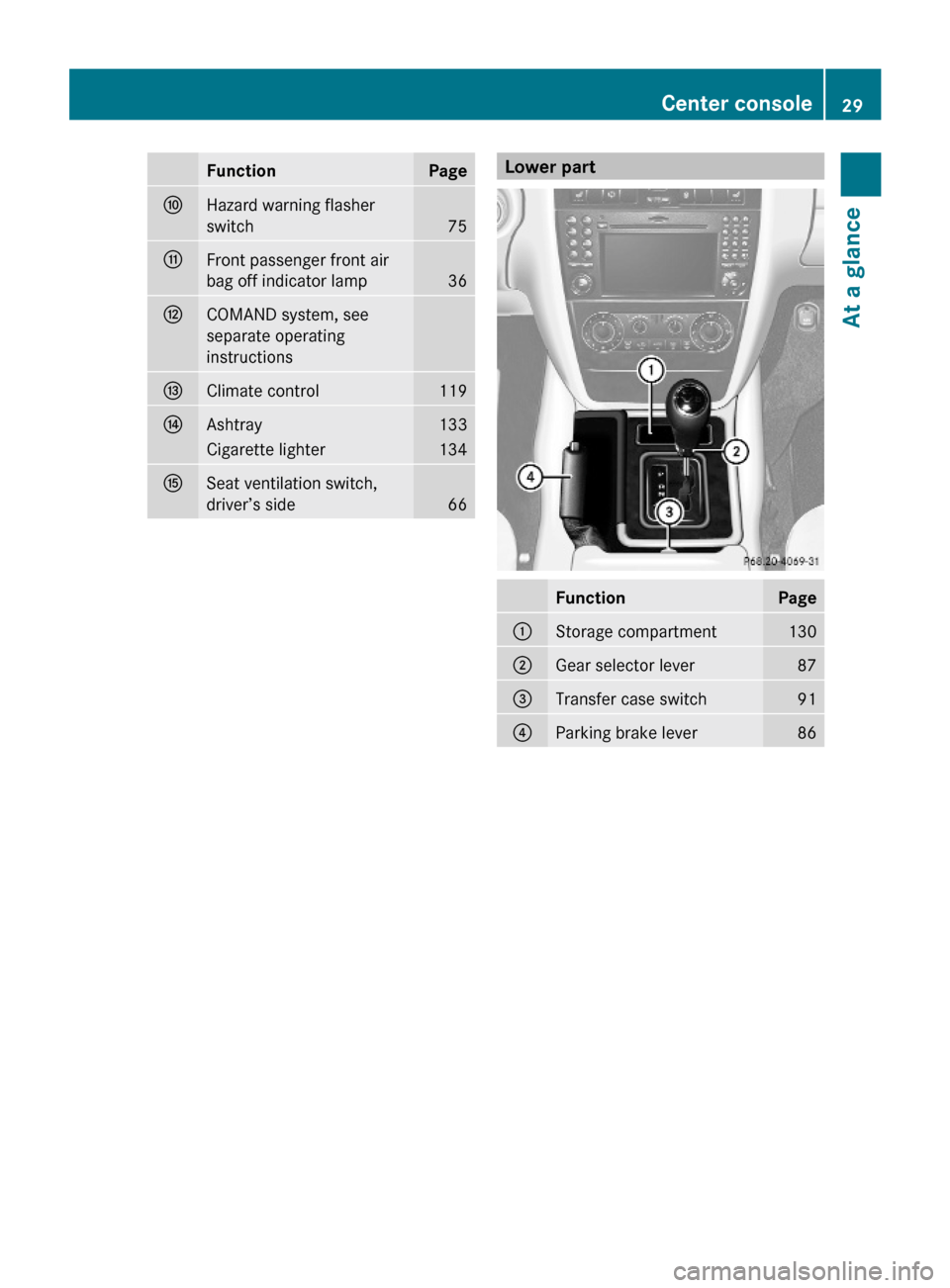
FunctionPageFHazard warning flasher
switch75
GFront passenger front air
bag off indicator lamp 36
HCOMAND system, see
separate operating
instructions
IClimate control119JAshtray133Cigarette lighter134KSeat ventilation switch,
driver’s side66Lower partFunctionPage:Storage compartment130;Gear selector lever87=Transfer case switch91?Parking brake lever86Center console29At a glance463_AKB; 2; 52, en-USd2ureepe,Version: 2.11.7.12008-12-02T10:52:11+01:00 - Seite 29Z
Page 32 of 264
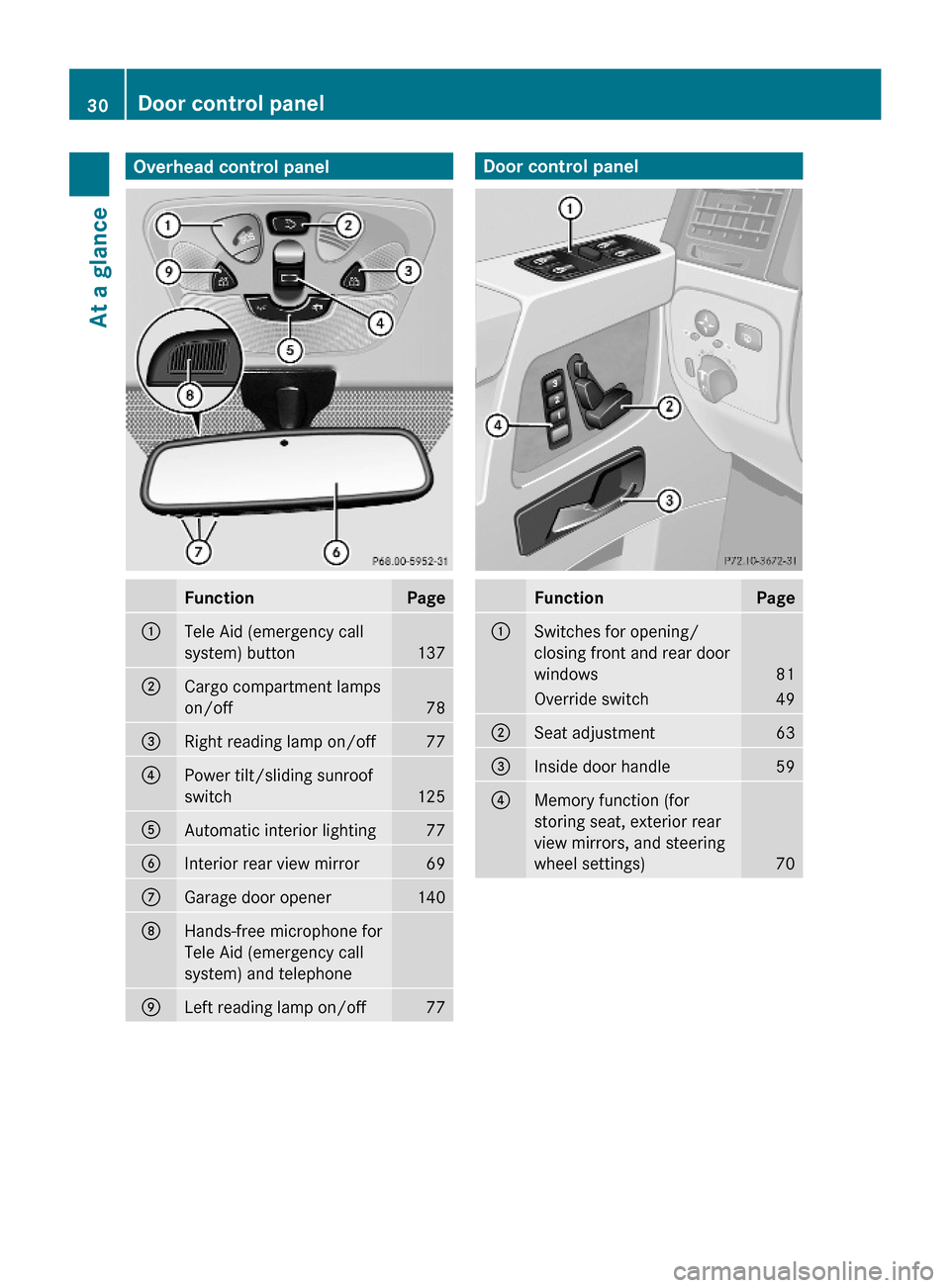
Overhead control panelFunctionPage:Tele Aid (emergency call
system) button137
;Cargo compartment lamps
on/off78
=Right reading lamp on/off77?Power tilt/sliding sunroof
switch125
AAutomatic interior lighting77BInterior rear view mirror69CGarage door opener140DHands-free microphone for
Tele Aid (emergency call
system) and telephone
ELeft reading lamp on/off77Door control panelFunctionPage:Switches for opening/
closing front and rear door
windows81
Override switch49;Seat adjustment63=Inside door handle 59?Memory function (for
storing seat, exterior rear
view mirrors, and steering
wheel settings)70
30Door control panelAt a glance
463_AKB; 2; 52, en-USd2ureepe,Version: 2.11.7.12008-12-02T10:52:11+01:00 - Seite 30
Page 33 of 264
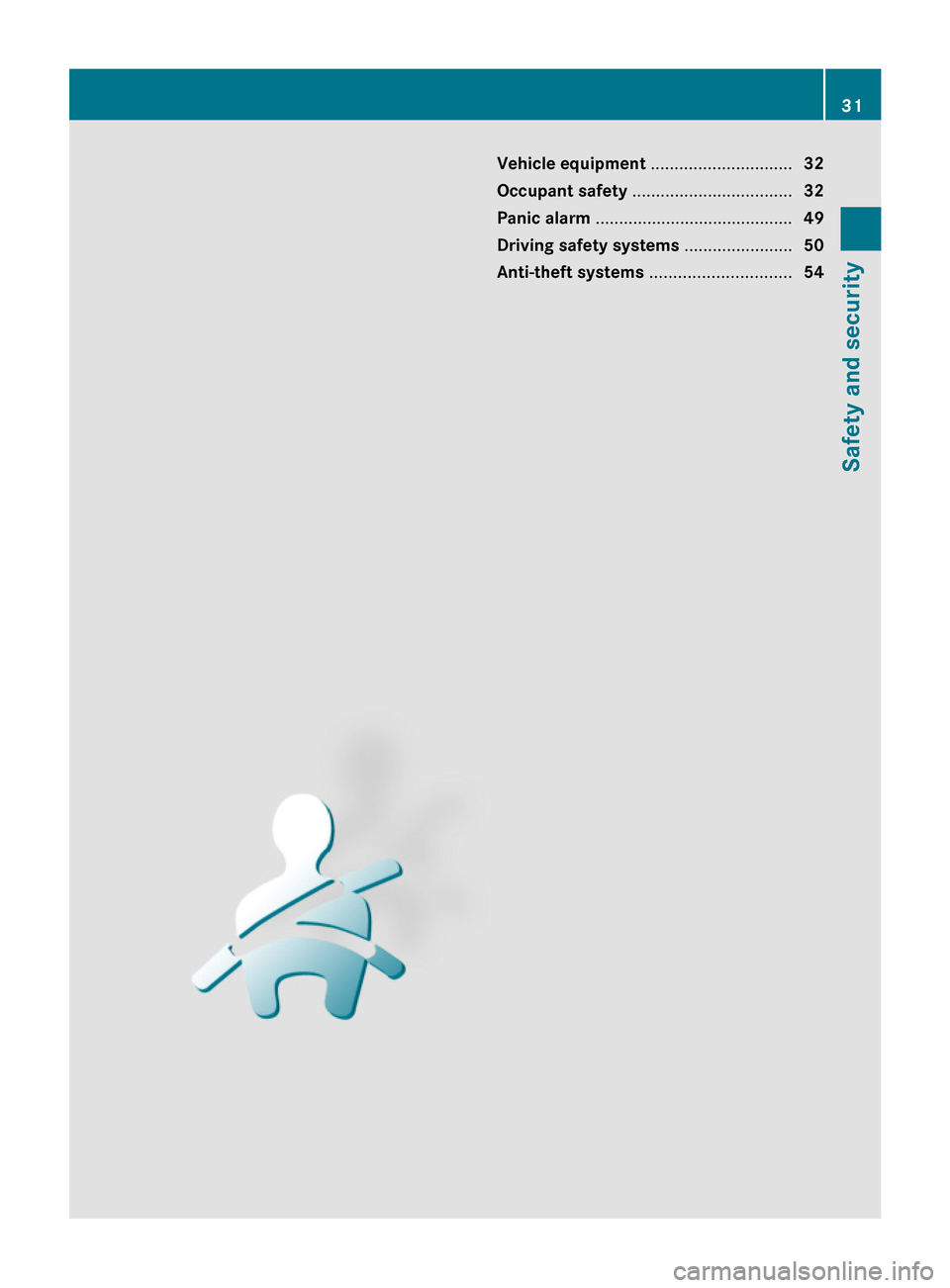
Vehicle equipment ..............................32
Occupant safety ..................................32
Panic alarm ..........................................49
Driving safety systems .......................50
Anti-theft systems ..............................54
31Safety and security463_AKB; 2; 52, en-USd2ureepe,Version: 2.11.7.12008-12-02T10:52:11+01:00 - Seite 31
Page 34 of 264
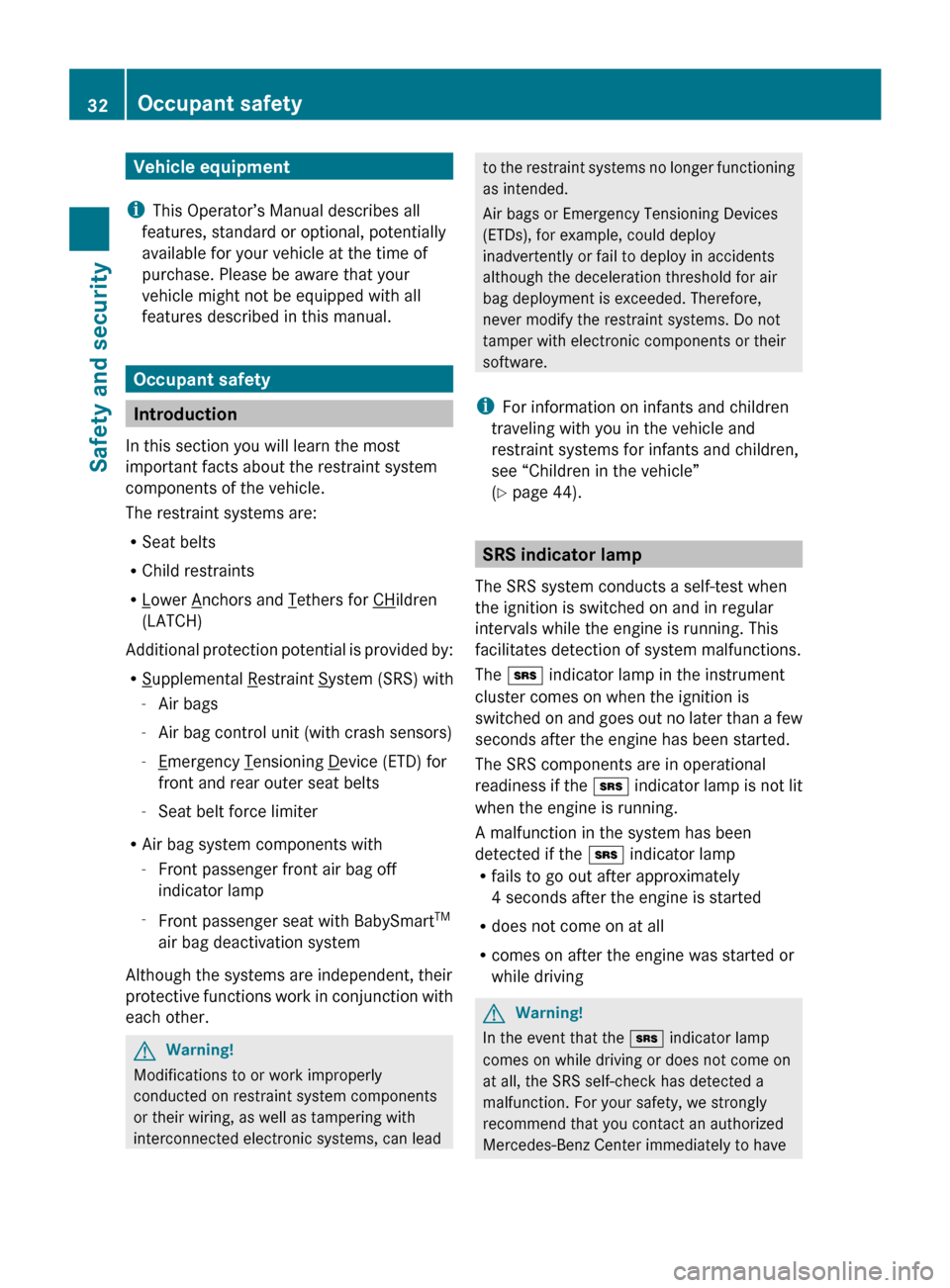
Page 35 of 264
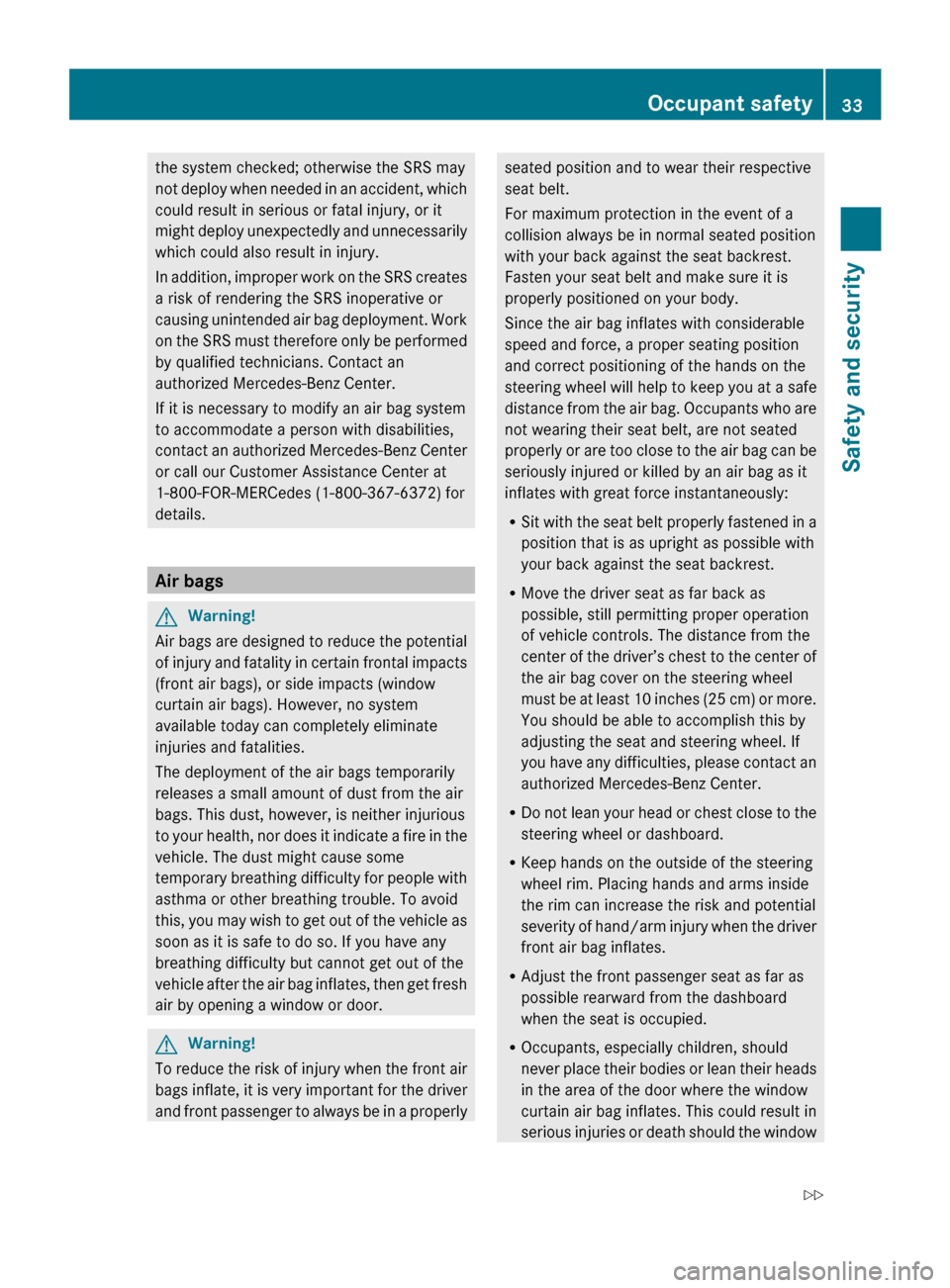
Page 36 of 264
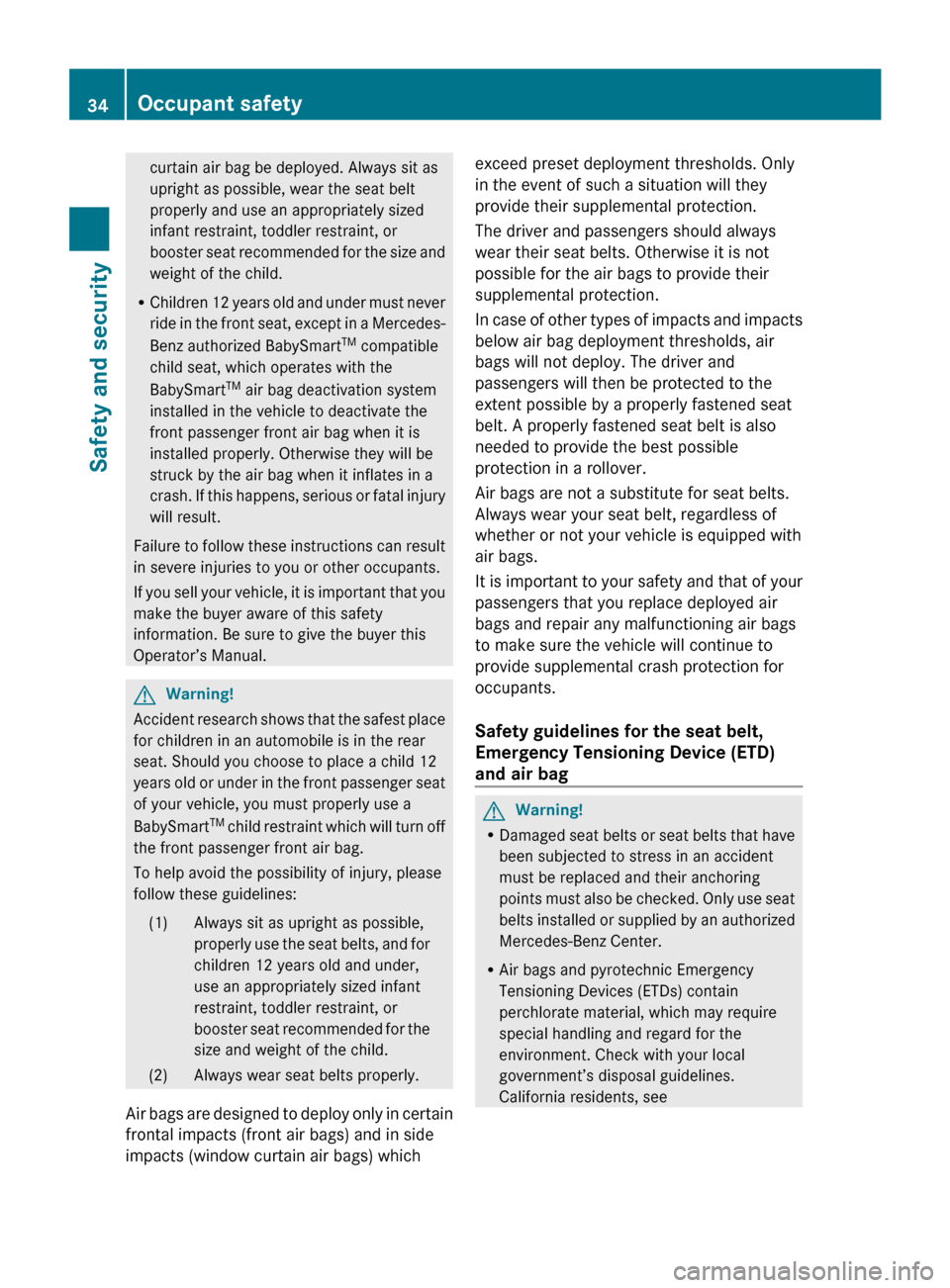
Page 37 of 264
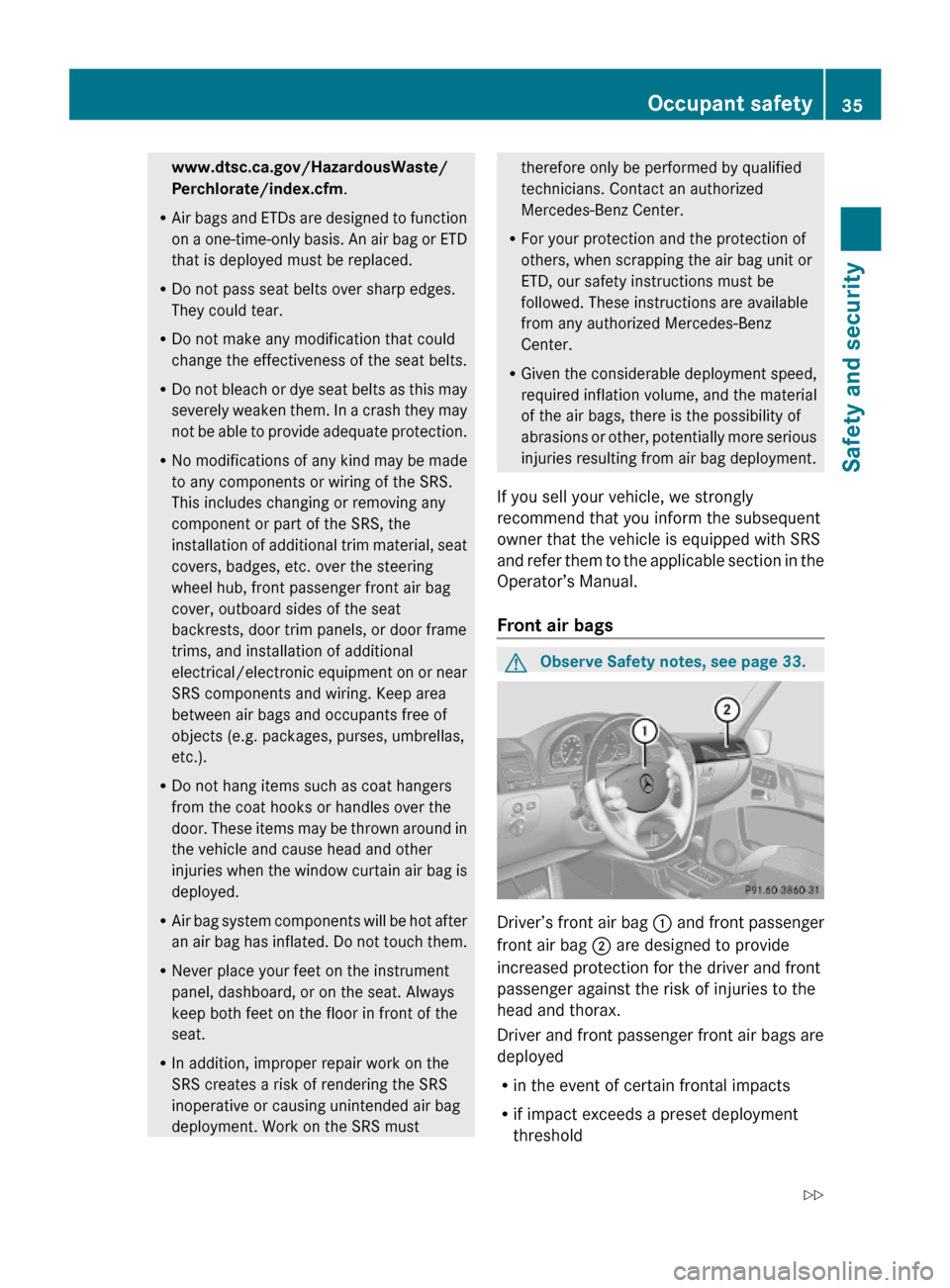
www.dtsc.ca.gov/HazardousWaste/
Perchlorate/index.cfm.
RAir bags and ETDs are designed to function
on a one-time-only basis. An air bag or ETD
that is deployed must be replaced.
RDo not pass seat belts over sharp edges.
They could tear.
RDo not make any modification that could
change the effectiveness of the seat belts.
RDo not bleach or dye seat belts as this may
severely weaken them. In a crash they may
not be able to provide adequate protection.
RNo modifications of any kind may be made
to any components or wiring of the SRS.
This includes changing or removing any
component or part of the SRS, the
installation of additional trim material, seat
covers, badges, etc. over the steering
wheel hub, front passenger front air bag
cover, outboard sides of the seat
backrests, door trim panels, or door frame
trims, and installation of additional
electrical/electronic equipment on or near
SRS components and wiring. Keep area
between air bags and occupants free of
objects (e.g. packages, purses, umbrellas,
etc.).
RDo not hang items such as coat hangers
from the coat hooks or handles over the
door. These items may be thrown around in
the vehicle and cause head and other
injuries when the window curtain air bag is
deployed.
RAir bag system components will be hot after
an air bag has inflated. Do not touch them.
RNever place your feet on the instrument
panel, dashboard, or on the seat. Always
keep both feet on the floor in front of the
seat.
RIn addition, improper repair work on the
SRS creates a risk of rendering the SRS
inoperative or causing unintended air bag
deployment. Work on the SRS must
therefore only be performed by qualified
technicians. Contact an authorized
Mercedes-Benz Center.
RFor your protection and the protection of
others, when scrapping the air bag unit or
ETD, our safety instructions must be
followed. These instructions are available
from any authorized Mercedes-Benz
Center.
RGiven the considerable deployment speed,
required inflation volume, and the material
of the air bags, there is the possibility of
abrasions or other, potentially more serious
injuries resulting from air bag deployment.
If you sell your vehicle, we strongly
recommend that you inform the subsequent
owner that the vehicle is equipped with SRS
and refer them to the applicable section in the
Operator’s Manual.
Front air bags
GObserve Safety notes, see page 33.
Driver’s front air bag : and front passenger
front air bag ; are designed to provide
increased protection for the driver and front
passenger against the risk of injuries to the
head and thorax.
Driver and front passenger front air bags are
deployed
Rin the event of certain frontal impacts
Rif impact exceeds a preset deployment
threshold
Occupant safety35Safety and security463_AKB; 2; 52, en-USd2ureepe,Version: 2.11.7.12008-12-02T10:52:11+01:00 - Seite 35Z
Page 38 of 264
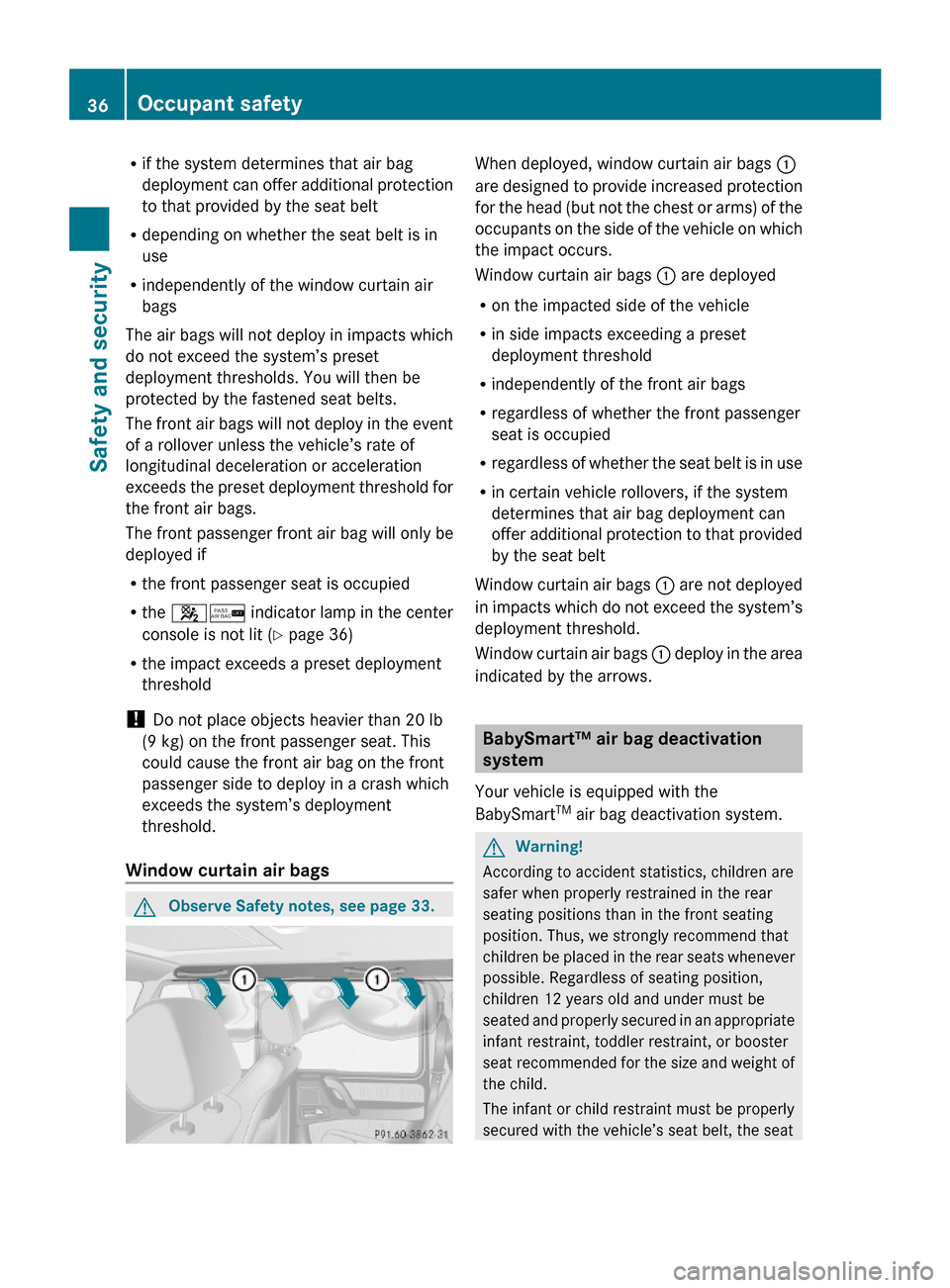
Rif the system determines that air bag
deployment can offer additional protection
to that provided by the seat belt
Rdepending on whether the seat belt is in
use
Rindependently of the window curtain air
bags
The air bags will not deploy in impacts which
do not exceed the system’s preset
deployment thresholds. You will then be
protected by the fastened seat belts.
The front air bags will not deploy in the event
of a rollover unless the vehicle’s rate of
longitudinal deceleration or acceleration
exceeds the preset deployment threshold for
the front air bags.
The front passenger front air bag will only be
deployed if
Rthe front passenger seat is occupied
Rthe 4/ indicator lamp in the center
console is not lit (Y page 36)
Rthe impact exceeds a preset deployment
threshold
! Do not place objects heavier than 20 lb
(9 kg) on the front passenger seat. This
could cause the front air bag on the front
passenger side to deploy in a crash which
exceeds the system’s deployment
threshold.
Window curtain air bags
GObserve Safety notes, see page 33.When deployed, window curtain air bags :
are designed to provide increased protection
for the head (but not the chest or arms) of the
occupants on the side of the vehicle on which
the impact occurs.
Window curtain air bags : are deployed
Ron the impacted side of the vehicle
Rin side impacts exceeding a preset
deployment threshold
Rindependently of the front air bags
Rregardless of whether the front passenger
seat is occupied
Rregardless of whether the seat belt is in use
Rin certain vehicle rollovers, if the system
determines that air bag deployment can
offer additional protection to that provided
by the seat belt
Window curtain air bags : are not deployed
in impacts which do not exceed the system’s
deployment threshold.
Window curtain air bags : deploy in the area
indicated by the arrows.
BabySmart™ air bag deactivation
system
Your vehicle is equipped with the
BabySmartTM air bag deactivation system.
GWarning!
According to accident statistics, children are
safer when properly restrained in the rear
seating positions than in the front seating
position. Thus, we strongly recommend that
children be placed in the rear seats whenever
possible. Regardless of seating position,
children 12 years old and under must be
seated and properly secured in an appropriate
infant restraint, toddler restraint, or booster
seat recommended for the size and weight of
the child.
The infant or child restraint must be properly
secured with the vehicle’s seat belt, the seat
36Occupant safetySafety and security
463_AKB; 2; 52, en-USd2ureepe,Version: 2.11.7.12008-12-02T10:52:11+01:00 - Seite 36
Page 39 of 264
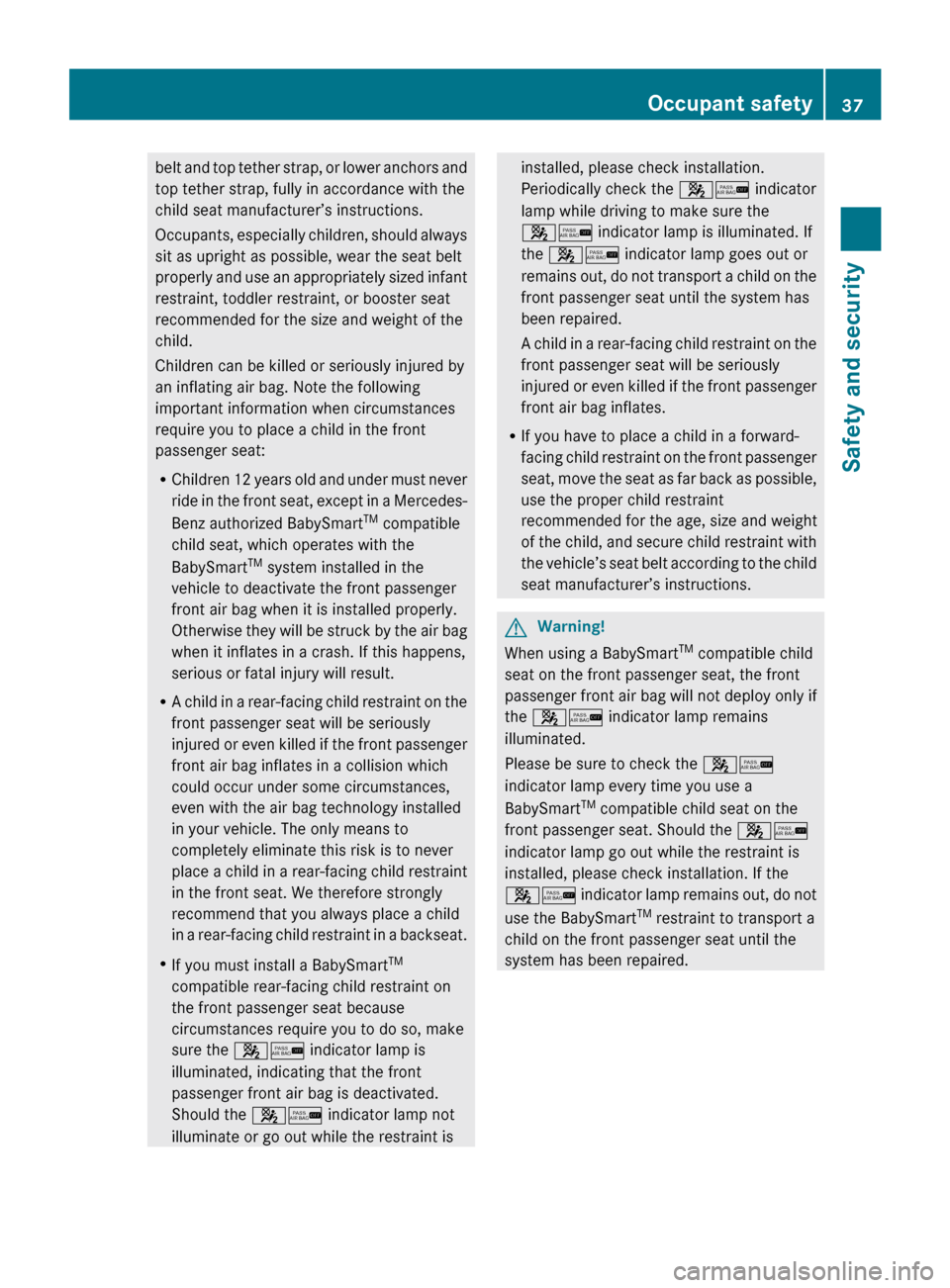
Page 40 of 264
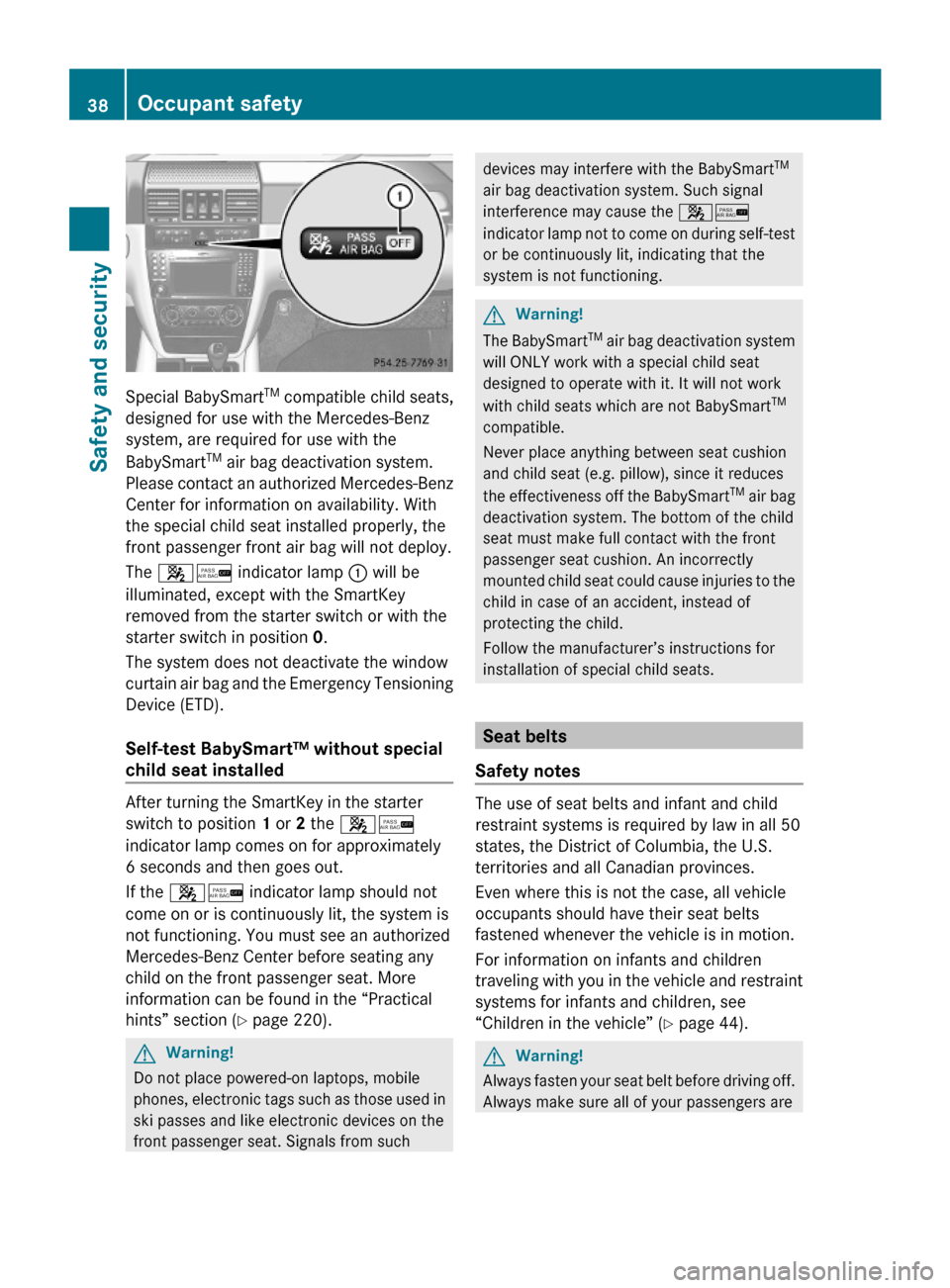
Special BabySmartTM compatible child seats,
designed for use with the Mercedes-Benz
system, are required for use with the
BabySmartTM air bag deactivation system.
Please contact an authorized Mercedes-Benz
Center for information on availability. With
the special child seat installed properly, the
front passenger front air bag will not deploy.
The 4/ indicator lamp : will be
illuminated, except with the SmartKey
removed from the starter switch or with the
starter switch in position 0.
The system does not deactivate the window
curtain air bag and the Emergency Tensioning
Device (ETD).
Self-test BabySmart™ without special
child seat installed
After turning the SmartKey in the starter
switch to position 1 or 2 the 4/
indicator lamp comes on for approximately
6 seconds and then goes out.
If the 4/ indicator lamp should not
come on or is continuously lit, the system is
not functioning. You must see an authorized
Mercedes-Benz Center before seating any
child on the front passenger seat. More
information can be found in the “Practical
hints” section (Y page 220).
GWarning!
Do not place powered-on laptops, mobile
phones, electronic tags such as those used in
ski passes and like electronic devices on the
front passenger seat. Signals from such
devices may interfere with the BabySmartTM
air bag deactivation system. Such signal
interference may cause the 4/
indicator lamp not to come on during self-test
or be continuously lit, indicating that the
system is not functioning.
GWarning!
The BabySmartTM air bag deactivation system
will ONLY work with a special child seat
designed to operate with it. It will not work
with child seats which are not BabySmartTM
compatible.
Never place anything between seat cushion
and child seat (e.g. pillow), since it reduces
the effectiveness off the BabySmartTM air bag
deactivation system. The bottom of the child
seat must make full contact with the front
passenger seat cushion. An incorrectly
mounted child seat could cause injuries to the
child in case of an accident, instead of
protecting the child.
Follow the manufacturer’s instructions for
installation of special child seats.
Seat belts
Safety notes
The use of seat belts and infant and child
restraint systems is required by law in all 50
states, the District of Columbia, the U.S.
territories and all Canadian provinces.
Even where this is not the case, all vehicle
occupants should have their seat belts
fastened whenever the vehicle is in motion.
For information on infants and children
traveling with you in the vehicle and restraint
systems for infants and children, see
“Children in the vehicle” (Y page 44).
GWarning!
Always fasten your seat belt before driving off.
Always make sure all of your passengers are
38Occupant safetySafety and security
463_AKB; 2; 52, en-USd2ureepe,Version: 2.11.7.12008-12-02T10:52:11+01:00 - Seite 38